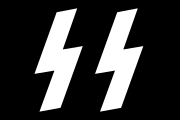Drohobycz Ghetto
| Drohobycz Ghetto | |
|---|---|
|
Commemorative plaque at the ghetto house of Polish writer and artist Bruno Schulz Drohobycz
Drohobycz location south of Belzec in World War II | |
| Also known as | Drohobych Ghetto |
| Location | Drohobycz, German-occupied Poland (now Ukraine) |
| Date | July 1941 to November 1942 |
| Incident type | Imprisonment, starvation, mass shootings, deportations to Bełżec extermination camp |
| Organizations | Nazi German SS, Orpo battalions |
| Victims | 10,000 Polish Jews |
Drohobycz Ghetto or Drohobych Ghetto was a World War II ghetto created by Nazi Germany in occupied Poland for the purpose of persecution and exploitation of Polish Jews in the city of Drohobycz after the Nazi takeover of the region in Operation Barbarossa. The ghetto was liquidated mainly between February and November 1942, when most local Jews of Drohobycz were transported in Holocaust trains to the Belzec extermination camp.[1]
Background
Before the Nazi-Soviet invasion of Poland, Drohobycz (Drohobych, now Ukraine) was a provincial city in the Second Polish Republic with 80,000 inhabitants,[2] the seat of Drohobycz county with an area of 1,499 km² and population of around 194,400. Drohobycz belonged to Lwów Voivodeship region of south-eastern Kresy, with a sizable Jewish population; exceeding that of Ukrainian and Polish.[3]
Following the invasion, the territory of the interwar Poland was divided in September 1939 between the Nazi Germany and the USSR. The city was attached to the Soviet Ukraine under the terms of the Ribbentrop-Molotov pact. In the expanded Soviet republic, Drohobych became a center of the Drohobych Oblast. The Soviet repressions of Polish citizens circled around the mass deportations to Siberia in cattle trains – men, women and children.[2] A group of local Polish boyscouts and soldiers of the defeated Polish Army created the clandestine White Couriers organization, which in late 1939 and early 1940 smuggled hundreds of people from the Soviet zone of occupation to Hungary, across the Soviet-Hungarian border in the Carpathians.[2]
Invasion of the Soviet Union
In early July 1941, during the first weeks of the anti-Soviet Operation Barbarossa, the city was overrun by the Wehrmacht,[4] and the District of Galicia was created. Drohobych had a petrol-producing plant essential for the German war effort. It became the site of a large, open type ghetto housing around 10,000 Jews,[2] a number of them employed at the local refinery.[5]
The following year marked the beginning of the Final Solution in the General Government. The first deportation action of 2,000 Jews from Drohobych to the Belzec extermination camp took place in late March 1942 as soon as the killing centre became operational.[5] The next deportation lasted for nine days in 8–17 August 1942 with 2,500 more Jews loaded onto freight trains and sent away for gassing. Another 600 Jews were shot on the spot while attempting to hide or trying to flee. The ghetto was declared closed from the outside in late September. In October and November 1942 some 5,800 Jews were deported to Belzec. During these round-ups about 1,200 Jews attempting to flee were killed in the streets with the aid of the newly formed Ukrainian Auxiliary Police.[5][6] The remaining slave-workers were transferred to labor facilities, with about 450 people murdered in February 1943. The last of the Drohobycz Jews were transported in groups to Bronicki Forest (las bronicki, i.e. Bronica Forest) and massacred over execution pits between 21 and 30 May 1943.[5]
One of the most notable inmates of the Drohobych Ghetto was Bruno Schulz, educator, graphic artist and author of popular books Street of Crocodiles and the Cinnamon Shops.[7] He painted murals for the children's room of one of the German officials before being shot, and after the war, became the most famous Polish writer detained and killed in the Ghetto. Drohobych was liberated by the forces of the Red Army on 6 August 1944.[8] There were only 400 survivors who registered with the Jewish committee after the war ended.[5]
Felix Landau participated is the mass executions and wrote about it in his daily diary.
Notes
- ↑ "History of Jews in Drohobycz". Virtual Shtetl. Museum of the History of Polish Jews. Retrieved April 6, 2012.
- 1 2 3 4 "Drohobych". Polacy na Wschodzie. KARTA Center with the Poles in the East Project. 2006. Retrieved April 10, 2012.
- ↑ "Drohobycz – local history". Virtual Shtetl. Museum of the History of Polish Jews. Retrieved April 6, 2012.
- ↑ Drohobych during the period of nazism // Drohobyczer Zeitung (photos)
- 1 2 3 4 5 Arad, Yitzhak (2009). The Holocaust in the Soviet Union. U of Nebraska Press. pp. 277, 282, 237. ISBN 080322270X. Retrieved 28 May 2014.
- ↑ Howard Aster, Peter J. Potichnyj (1990). Ukrainian-Jewish Relations in Historical Perspective. CIUS Press. p. 415. ISBN 0920862535. Retrieved 28 May 2014.
- ↑ "Hitler's Furies" by Wendy Lower. ISBN 0547807414
- ↑ События 1944 года (Events of 1944) at Hronos.ru
